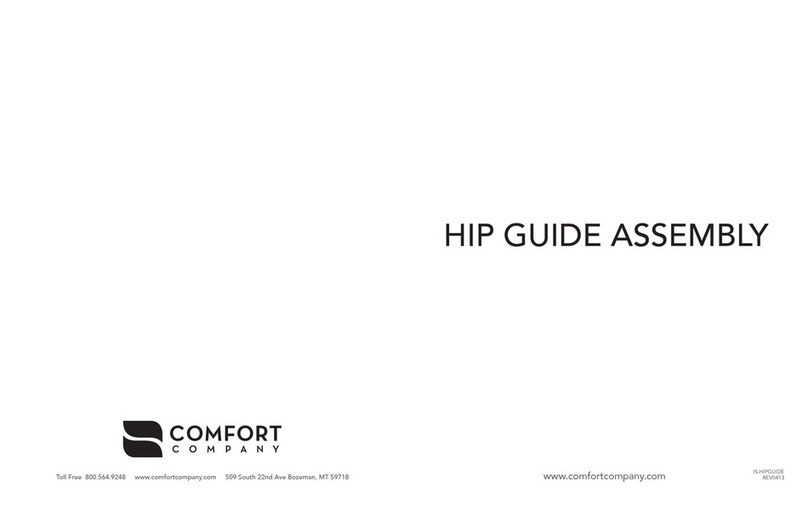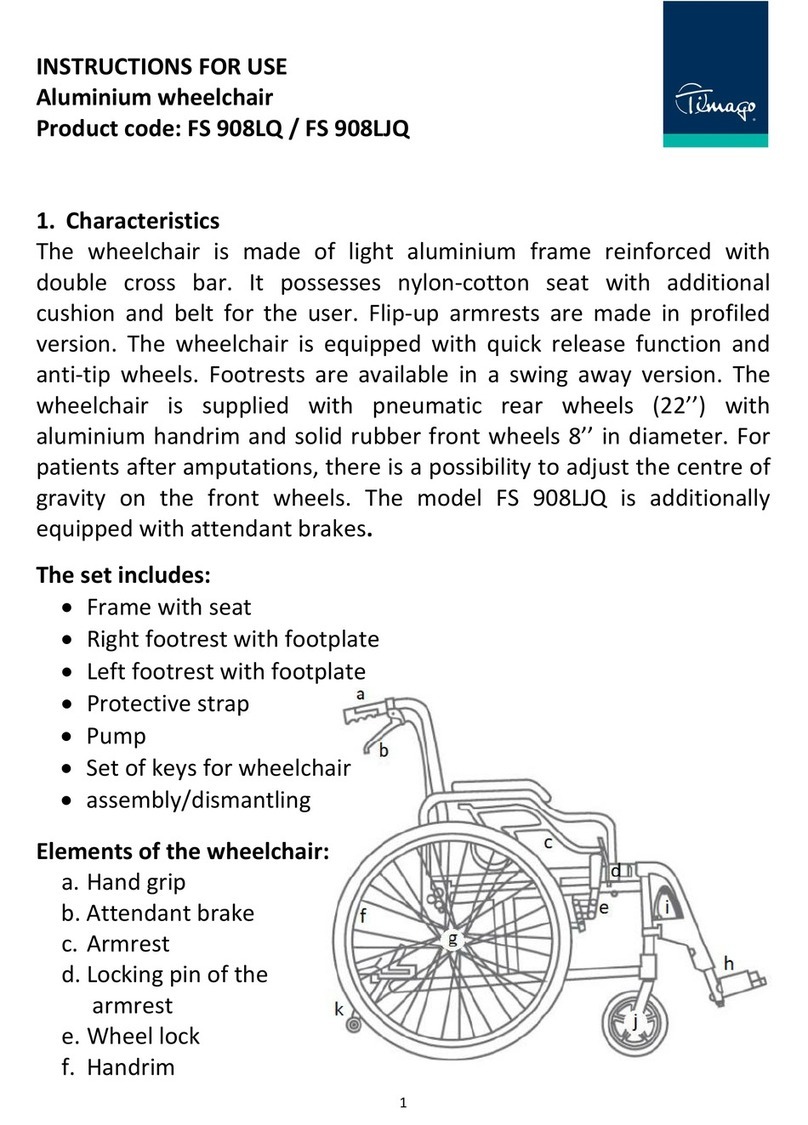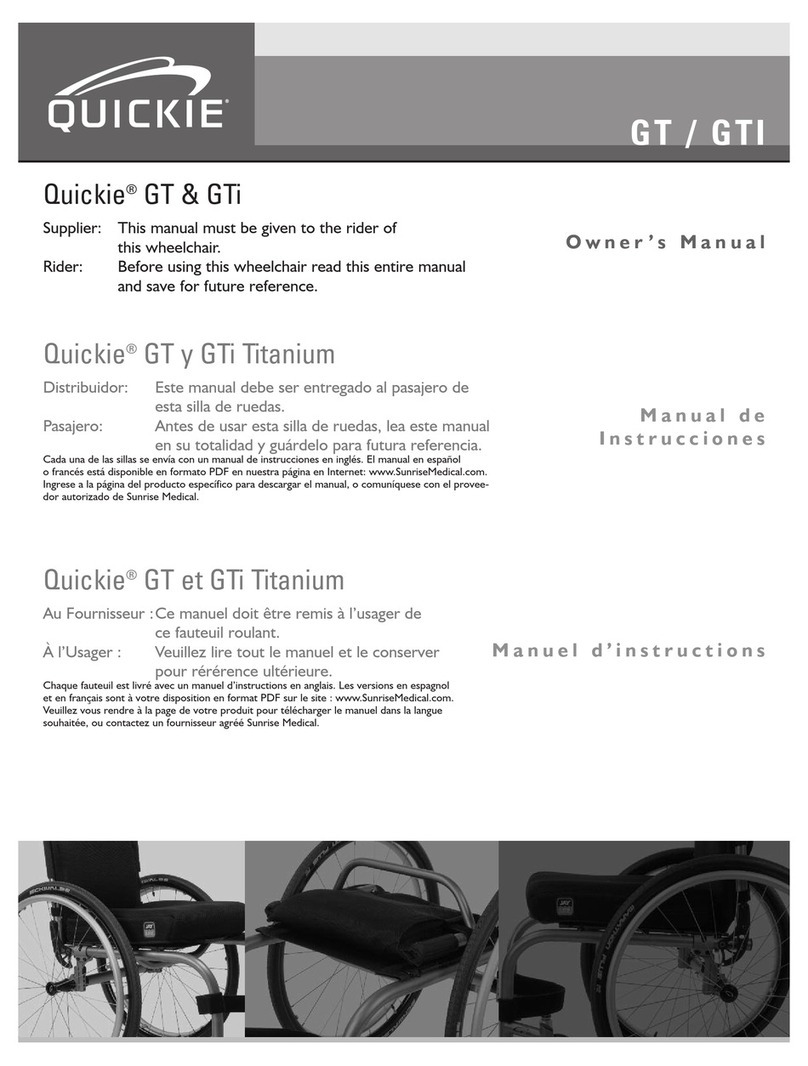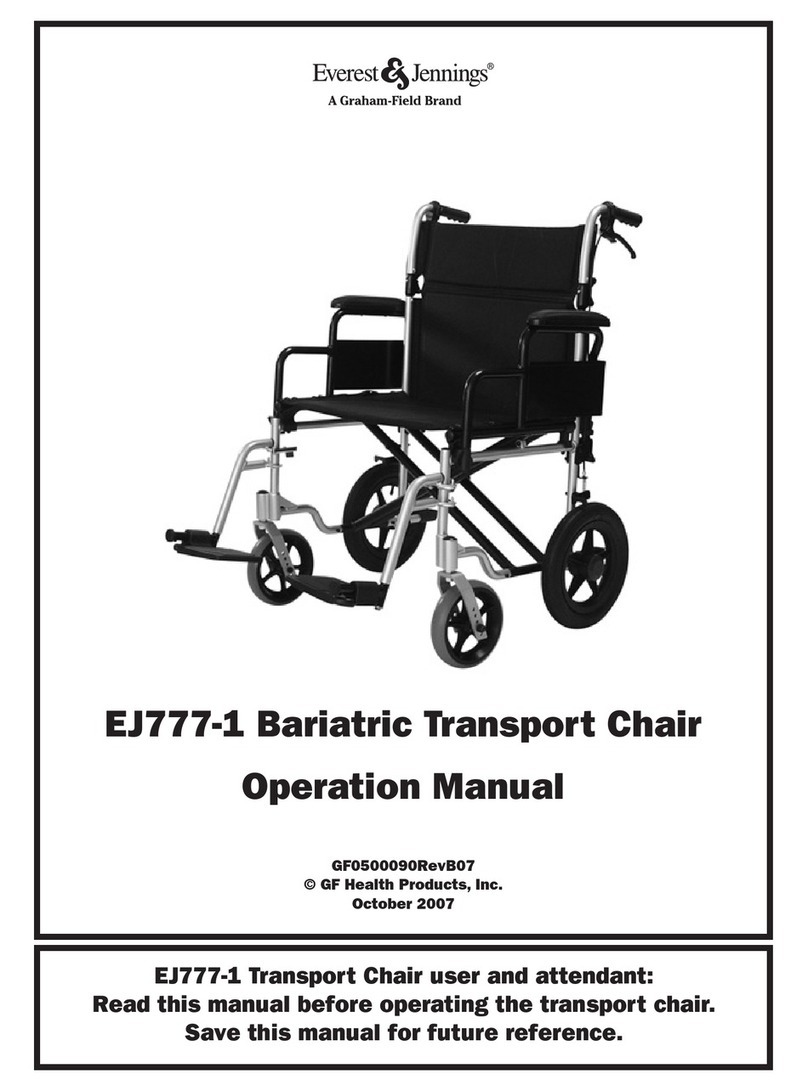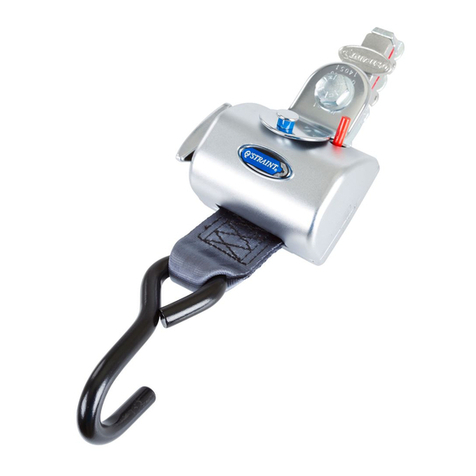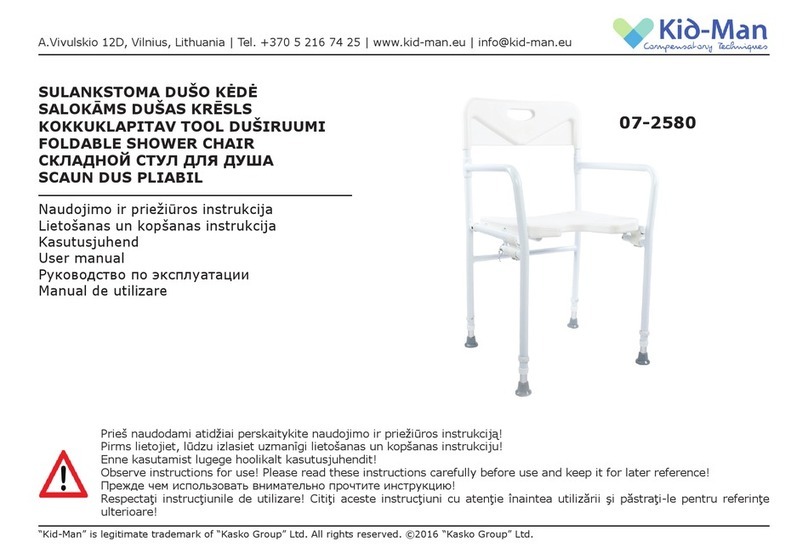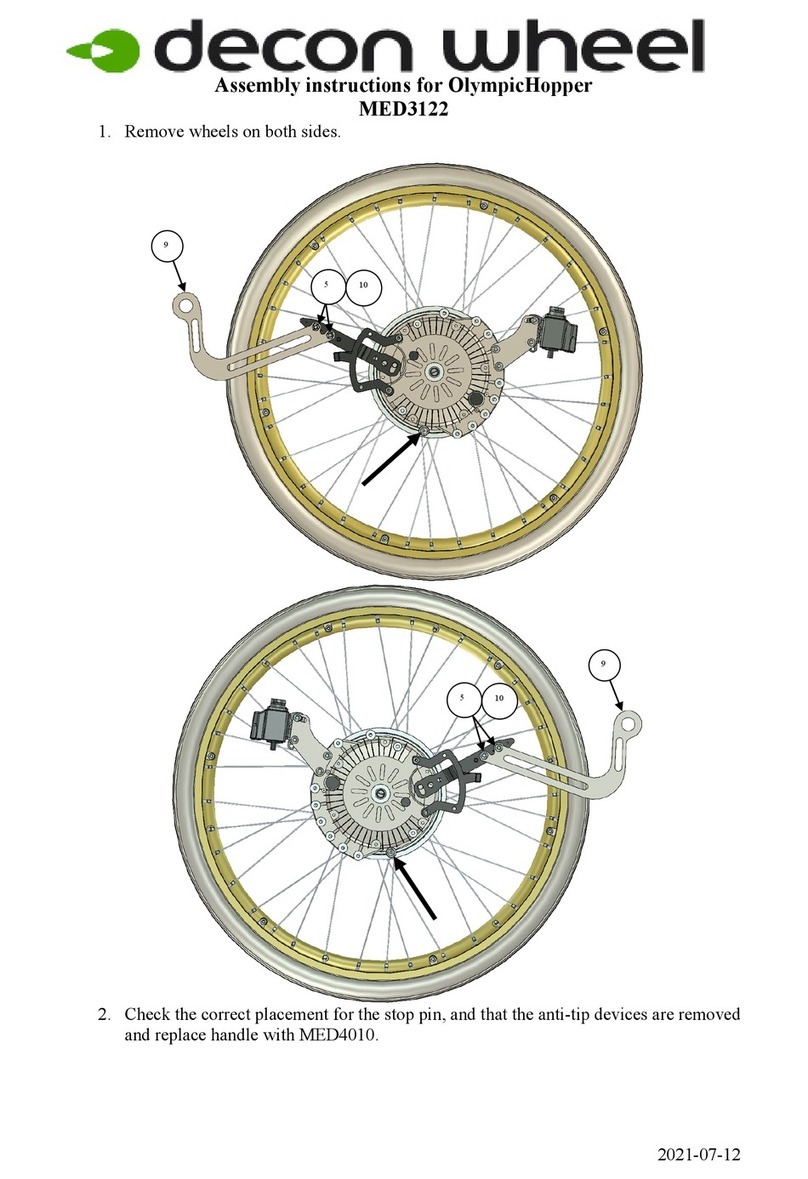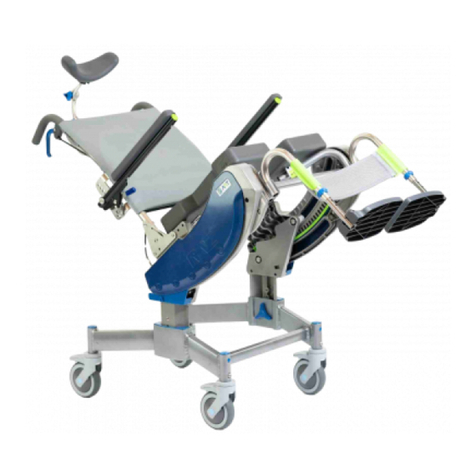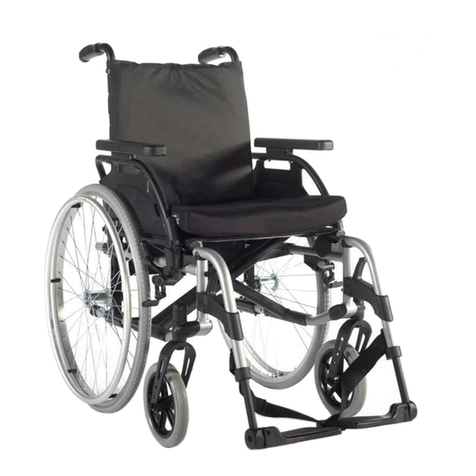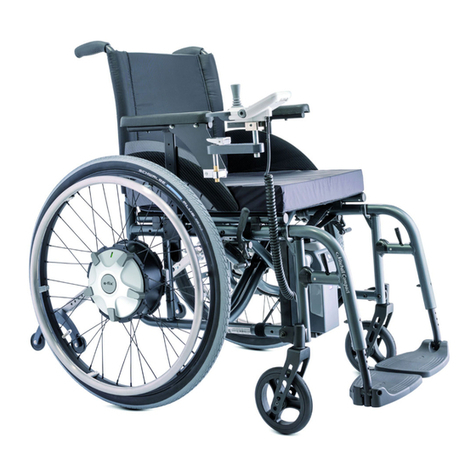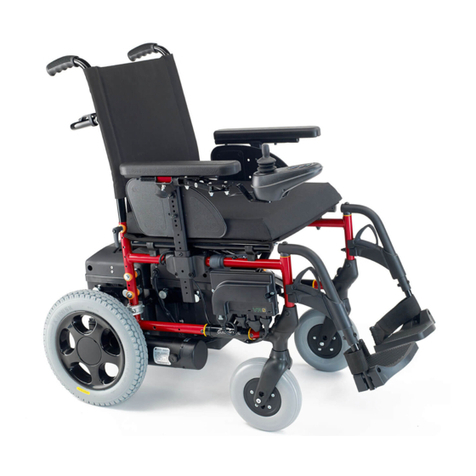Blatchford Nimbus Instruction manual

Quick User Guide for
Users, Parents and Carers
A passion for posture

936941/2-0917
Quick User Guide for Users, Parents, and Carers
Beware of nger trap hazards.
Introduction 3
Pre-Use Checks 3
Installing the Nimbus on a Wheelchair or a Static Base 3
Adjusting the Head Support5
Posture Belts and Posture Harnesses 5
Lateral Trunk Supports and Lateral Thigh Supports 6
Medial Thigh Support (Pommel) 6
Lateral Supports 6
General Cleaning Instructions 6
Dartex Cleaning Instructions 7
Transporting the User in a Motor Vehicle 8
Further Information 9
Technical Specication 10

3
936941/2-0917
Introduction
The Nimbus is a modular seating system that is set by a healthcare professional to meet the
needs of the user. It is a CE marked product, however it should not be used by anyone else
without being adjusted to meet their needs. This can only be carried out by a trained therapist or
rehabilitation engineer with specialist postural-management knowledge.
This guide contains important information and safety advice. Read this guide carefully and keep
it for future reference.
It would also be useful for any other carers to read this guide. If you need additional copies
of this guide you can contact us, photocopy this guide, or download it from our website at:
blatchford.co.uk/products/nimbus-modular-seat
Pre-Use Checks
Before using your Nimbus seating system, please make sure that:
• The seat is secured onto the base of either a wheelchair or a static base, as directed by your
healthcare professional. Please also check the Blatchford website for a reminder if required at:
blatchford.co.uk/seating
• The posture belt, pelvic stabiliser and posture harness, if tted, are secured as per the
manufacturing instructions and as advised by your healthcare professional.
• Any wrapped covers on the supports are secured to reduce the risk of nger trap hazards.
This is important, and is in line with the Medical Devices Alert, as there is a risk of serious
injury or death of the person using a posture or safety belt that isn’t tted or adjusted
properly. (MDA/2015/018).
If you have any doubts, contact your healthcare professional or check the website for a
further instructional video.
Installing the Nimbus on a Wheelchair or a Static Base
Typically our seats are attached to the wheelbase by means of a system called an interface.
The following list includes the different types of interface. You or your healthcare professional will
have selected one that meets your particular needs.
• Nimbus xed interface (non-removable);
• Blatchford adaptive interface (BAIS) for folding-frame wheelchairs;
• Blatchford adaptive interface (BAIS) for xed-frame wheelchairs or static bases;
• Others, selected by your service provider: please ensure you are aware of the instructions for
safe and ease of use before leaving the centre.
Healthcare professional to complete:
TYPE OF INTERFACE FITTED
Date Handed Over ________________________________________________________________
User/Carer Given Instruction _______________________________________________________
If the BAIS has been selected, please see instructions BAIS – Blatchford Adaptive
Interface System.

4
936941/2-0917
Removing the Seating System from the Interface
1. Undo or disconnect the back support xings.
2. Pull the D-ring (g.6, located under the front of the seat)
rmly and lean the seating system forward.
3. Taking care, lift the seating system upward and clear from
the wheelchair.
Attaching the Seating System
to the Interface
1. Taking care when lifting, install the
seat on the interface and locate the
front hook onto the front bar (g.5).
2. Allow the seat to tilt backwards and
down, pressing it rmly into place.
A click will be heard as the locks engage.
3. Check that the pins have fully located by pulling the seat forward, (a small amount of
movement is normal). However, the seat should not lift forward.
4. Repeat stages 1 to 4 if the seat lifts from the interface.
Fitting the Interface to the Wheelchair (Applies to folding wheelchairs only)
Components:
AInterface
BLatch Clamps
CSeating Attachment
BAIS - Blatchford Adaptive
Interface System
3
g. g.
g.
g.
g. 1
g. 2g. 3
g. 4
g. 6
5
A B C
1. Make sure that the wheelchair is fully open.
2. Make sure that the latches are open. (g.1).
3. Position the interface hooks so that on each side, one hook is behind and one hook
is in front of the clamps (g.2 and g.3).
4. Slide the latch clamps so that the tongue is over the top of hooks (g.4).
5. Check that the interface is correctly located by trying to lift it out (a small amount of
movement is normal).
6. To remove the interface, move the latches back and lift the interface.

5
936941/2-0917
Adjusting the Head Support
The height, the depth and the angle of the head support
are adjustable (g.7).
• To adjust the height of the head support turn the locking
knob (A) anticlockwise. Alter the height to suit the user
and retighten the knob.
• To adjust the depth of the head support, turn the locking
knob (B) anticlockwise. Alter the depth of the
head support to suit the user and retighten the locking
knob.
• To adjust the angle of the head support (C) please
consult your healthcare professional.
Note: The head support should be in place when transporting the user in the Nimbus.
Posture Belts and Posture Harnesses
Blatchford posture belts and harnesses are designed to aid posture and can be used as part of
a specialised seating system or standard wheelchair seating.
Safety Information
Blatchford posture belts and harnesses are
designed to aid posture both in and out of a
vehicle. They are not safety devices and must
never be used as a passenger restraint.
A separate 3-point user restraint system (fastened
into a vehicle) must be used, in line with the
recommendation of the wheelchair manufacturer,
to secure the user during travel.
Always make sure that posture belts and
harnesses t the user comfortably and securely.
Posture harnesses should always be fastened
around the body. Always allow enough space
between the neck and the harness to ensure it
does not pose a choking hazard.
A posture harness must always be used with
a posture belt. If the posture belt or harness is
loose, the user can slide down in the seat, which creates a choking hazard. Therefore, to
reduce the risk of choking, make sure the posture belt and harness are secure.
Cleaning
Wipe posture belts and harnesses with a damp cloth and a mild detergent (please do not
use bleach or products containing bleach). For machine washing, we recommend that the
temperature is set to 40 °C. Do not tumble dry.
g. 7
A
B
C

6
936941/2-0917
Lateral Trunk Supports and Lateral Thigh Supports
Your healthcare professional ts and adjusts the lateral trunk supports,
lateral thigh supports, lateral knee supports and pommel. If you believe
that the setup of these supports no longer meets your needs, contact your
healthcare professional for advice.
Medial Thigh Support (Pommel)
To remove the pommel, loosen the black wing nut in the middle of the front of the seat (it is not
necessary to remove the wing nut completely). Once the wing nut is loose,
lift the pommel and remove it.
To replace the pommel, make sure that the wing nut is sufciently loose
and slide the plate over the metal pin and behind the wing nut. Once in the
correct position, tighten the wing nut.
Lateral Supports
We offer both swing-away lateral supports and xed lateral supports. If your
seating system is tted with swing-away lateral supports, make sure that you are familiar with the
swing-away mechanism and that you do not use excessive force to operate it.
Swinging the swing-away lateral support
1. Hold the support as close to the back support as
possible.
2. Lift the support rmly until it disengages, then swing it
to the side.
3. To x the support in place, push it into position until it
locates and locks.
Note: You might need to lean the user away from the
lateral support before xing it in place.
General Cleaning Instructions
We recommend that you do not remove the covers for washing.
Use a damp cloth to clean the covers.
Do not use bleach or any harsh soaps.
Clean regularly as part of routine maintenance and fabric hygiene.
Allow to dry before reuse.
Use disinfectants according to the manufacturer’s instructions.
It is crucial that any staining is treated as soon as possible and never later than 24 hours.
Note: These are recommended methods of cleaning. The manufacturer is not responsible for
damage incurred while cleaning. Always try the cleaning method in a hidden area rst to see the
results. Remember if you are not sure contact your service provider before proceeding.

7
936941/2-0917
Dartex Cleaning Instructions
Important: Do not use phenols, alcohols, bleaches, or other abrasive materials to clean Dartex
fabrics.
Machine washing
Wash at up to 40°C.
Dry thoroughly before use.
Hand Cleaning
Use a cloth and a solution of both neutral detergent and warm water.
Thoroughly rinse with clean water to remove residual cleaning chemicals.
Dry thoroughly before use.
Disinfecting
Use a 0.1% chlorine solution (1,000 ppm).
Thoroughly rinse with clean water to remove residual cleaning chemicals.
Dry thoroughly before use.
Drying
When polyurethane-coated fabrics are damp, they are vulnerable to damage. Therefore, always
dry Dartex fabrics thoroughly before use.
Note: When polyurethane-coated fabrics are damp, they feel cold.
Do not tumble dry or iron.
Dry thoroughly before use.
Immediately remove stains caused by bodily uids.

8
936941/2-0917
Transporting the User in a Motor Vehicle
Notes:
• Do not use Nimbus as a separate car safety seat.
• When installed on a wheelchair with either the BAIS or the Nimbus xed interface, the Nimbus
is suitable for transporting the user in a suitably-equipped motor vehicle.
• Blatchford special seating products are interfaced using either the BAIS or the Nimbus xed
interface, which conform to ISO 16840.
Warnings:
1. Always place Nimbus in a forward-facing position.
2. Only use the Nimbus with wheelchair bases that full the following requirements:
i. Wheelchair bases that are tested as part of a wheelchair system that conforms to
ISO 7176-19.
ii. Wheelchair bases that have securement points for use with four-point,
strap-type tiedowns.
3. Carry out one of the following steps for wheelchair-mounted trays that are not intended
for use in a motor vehicle:
a. Remove the wheelchair-mounted tray and secure it separately in the motor vehicle.
b. Secure the wheelchair-mounted tray to the wheelchair, move the tray away from the
user, and place energy-absorbing padding between the tray and the user.
Transportation - Essential Safety Information.
Give this information to anyone who makes transport arrangements (for example, schools and
other organisations).
Securing the user, the Nimbus, and the wheelchair in a vehicle
• During travel, the Nimbus must be securely fastened into the wheelchair. Make sure that the
dynamic back support is locked off for transport.
• Posture belts and posture harnesses are designed to aid posture. Where they are tted they
should be used during travel, but they must not be used as the only safety restraints.
• The wheelchair must be fastened down in the vehicle, in
accordance with the wheelchair manufacturer’s instructions. (The wheelchair
manufacturer issues these instructions separately. For queries, contact your
healthcare professional).
• The user must wear a suitable, separate user restraint system during travel. In order to
achieve user restraint and optimum protection in a crash situation, the seat belt should
have both pelvic and upper body sections (for example a 3-point type with the upper
section fastened into the vehicle at the upper level) as a minimum standard.
Using Nimbus Accessories During Travel
Consult the information sheets that are issued with accessories.
• The Nimbus head support is approved for use in transportation.
• Footstraps are not designed to be a part of a passenger restraint system but,
where these are tted, there may be advantages in these being used during
travel. (Again these issues should be considered as part of the initial assessment
by your healthcare professional and recommendations made to the people making the
transport arrangements.)

9
936941/2-0917
Important Reminders
It is important that the carer is aware of the following information:
The Nimbus is a CE marked device however it has been set to meet the needs of the user.
Please do not allow anyone else to use the seat.
If the user has any marking on the skin or becomes uncomfortable please contact your
healthcare professional immediately.
The Nimbus can t onto a number of wheelchair bases and static seating systems however
please do not t Nimbus onto other bases that have not been specically supplied and set for
use with the Nimbus. Contact your healthcare professional for further advice.
Maintenance and adjustments must only be carried out by a trained person. Do not carry out
any maintenance or repairs yourself. If you have any concerns please contact your healthcare
professional.
The Nimbus is not designed for use as a separate car safety seat.
Further Information
Please contact your healthcare professional if you have further questions about any of the
following:
• Availability of seating accessories.
• Changing a Nimbus seating system to t a different wheelchair.
• Use of the seating system in a motor vehicle.
• Information on the crash testing of Nimbus.

10
936941/2-0917
Weights of Nimbus Accessories (for use when determining User + Nimbus load on wheelbase)
Technical Specication
Safe Transportation
Nimbus has been fully crash tested. If a
dynamic back support is tted, it must
be locked during transportation.
Quality and Safety
Nimbus conforms to ISO 16840-
4:2009. The fabric covers are rated to
BS7176 Crib5.
Seating System Size
All measurements provided in mm
Small Medium Large
Min Max Min Max Min Max
A - Seat Depth 250 380 290 430 360 490
B - Seat Width 160 330 190 380 230 440
C - Back Support Height 420 550 480 620 520 700
D - Overall Width
*with lateral thigh supports
**with lateral knee supports
340*
320**
510*
545**
395*
435**
550*
585**
465*
485**
590*
630**
Seat-to-Back-Support Angle -10° (anterior tilt) to +50° (posterior tilt)
in 5° increments
Dynamic Back Support Movement Up to 40°
Seating System Weight* 11.5 kg 12.5 kg 15.5 kg
Max. User Mass 100 kg (user)
*Seating system weight: Basic seat, consisting of xed back, base and cushion, adjustable anti-thrust block, lateral thigh supports, back support and
cushion, xed laterals, adjustable pelvic support and pad and Nimbus xed interface.
Accessory Weight of accessory -
kg - (single items only)
Nimbus Head Support 1.0
Curved Head Support 1.0
Anti-Roll Head Support 0.5
Pelvic Cradle 0.5
Arm Retraction Pads
(pair) 0.5
Swing-Away and Fixed
Lateral Trunk Support
(pair)
1.0
Lateral Thigh Support
(pair) –
small & large
1.0 all sizes
Pommel 0.5
Foot Box 2.5 small medium
3.0 large
Accessory Weight of accessory -
kg - (single items only)
Shoulder Harness 0.25
Dynamic Buttery Harness 0.25
Single Pull Posture Belt 0.25
Dual Pull Posture Belt 0.25
Pelvic Stabiliser –
Single Pull Metal Buckle 0.25
Pelvic Stabiliser –
Dual Pull Metal Buckle 0.25
Dynamic Back –
Additional weight com-
pared to xed back
1.0
BAIS interface –
additional weight to Nim-
bus xed interface
1.5

11
936941/2-0917

936941/2-0917
Supplier’s Contact Details
Supply Service_____________________________________________________________________
Healthcare Professional _____________________________________________________________
Contact No. _______________________________________________________________________
blatchford.co.uk
0114 263 7900
Follow Blatchford:
@BlatchfordGrp
/
BlatchfordGrp
Registered Address: Chas A Blatchford & Sons Ltd,
11 & 30 Atlas Way, Shefeld, S4 7QQ, United Kingdom.
Other manuals for Nimbus
1
Table of contents
Other Blatchford Wheelchair manuals

